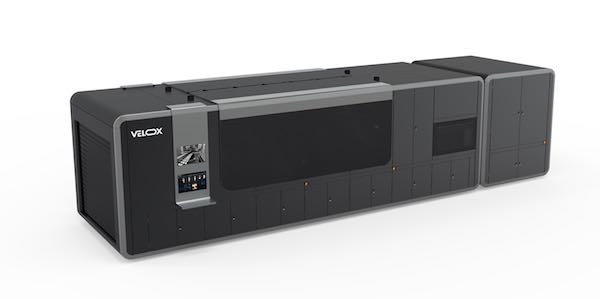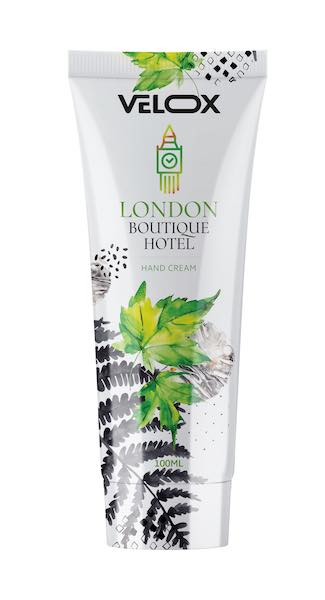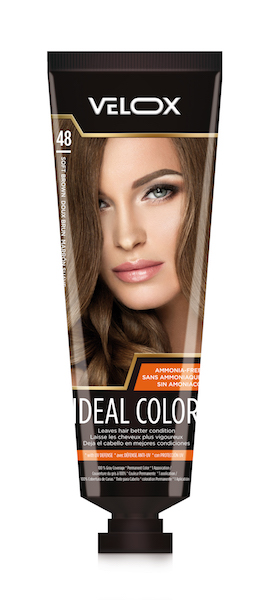By Richard Romano
(For a general overview of the market opportunities for commercial print providers in direct-to-shape printing, see Pete Basiliere’s complementary feature here.)
Israel’s Velox, founded in 2012, specializes in industrial-scale direct-to-shape digital printing—or, as the company calls it, “decorating”—predominantly on tubes, aerosols and other cylindrical items. Velox has developed both the ink and the system architecture and the two “pillars” of its DTS-Inkjet technology are:
- Adaptive Deposition Architecture™ (ADA), its unique printing process, and
- Variable Viscosity Ink™ (VVI), a specially formulated digital UV ink series that tackles the age-old problem of printing on sometimes print-unfriendly surfaces.

The Velox IDS 250.
The target materials for the Velox printing system are plastic, laminate and aluminum tubes and aerosol cans, and it can print the full 360° without a gap or any kind of overlapping. The 14 colors and embellishments included in the system provide ultra-wide color gamut and accurate color matching. It can also print on the cap simultaneously. The company’s IDS Series is indeed geared for high production: the flagship IDS 250 can produce up to 250 containers per minute (naturally, your mileage will vary). However, it being a digital printing process, the Velox technology also supports short runs and on-demand production.

Plastic tube decoration is the hallmark of the Velox IDS system. Note that it can even print on the cap at the same time.
The Velox system can handle objects with diameters from 25 mm to 60 mm. Converters often work with three or four different size containers, and the mandrels that convey the containers through the press can be easily swapped out to handle different diameters.

Cylindrical shapes are also supported on the IDS 250.
The company is also developing the ability to print on other kinds of cylindrical objects, such as plastic, glass, and aluminum bottles; beverage cans; glass and plastic jars; and more.

Velox technology can also print on aluminum tubes, and can enable unique substrate/color interactions.
In addition to printing, the Velox system can also add embellishments such as digital gloss/matte varnishes and embossing, all in the same pass.

The IDS 250 can add tactile features such as textures and embossing during the printing process.
The types of brand owners that Velox is targeting at present include those that produce cosmetics, food and beverage, home and personal care, pharmaceuticals, and oral care.
Velox is positioning its system in part as a substitute for analog decoration technologies, as well as label printing. “The trends today are toward much higher quality, more unique decoration on containers or packaging, and many more SKUs,” says Merav Sheffer, Marketing Manager, Velox. “There is a bigger demand for shorter time to market and on-demand and to not have to wait few months to get orders fulfilled.” Like a lot of digital production manufacturers, Velox finds itself at the intersection of where analog meets digital. “[The Velox system] has all the benefits and the advantages of digital, but it’s also for mass production,” says Sheffer. “So it has the value, the volume, and high-speed mass production. Basically, we say you can take out all your analog technologies and replace them with the Velox system because it has all those benefits.”
Image quality, and ink economy, are optimized using the aforementioned Variable Viscosity Ink. “A special characteristic of our inks is that we can control the drop shape,” says Sheffer. “The drops are all the same size and when they touch the surface, they behave differently. This is why we can save on ink consumption.” For example, in large areas of color, like solids, says Sheffer, “we can let the drop spread out. And when we want very accurate detail, we will keep it from spreading.”
The company is also touting it as a more ecofriendly solution, throughout the entire production workflow. For example, when it comes to replacing labels, the company estimates that it saves up to 27 tons of plastic, a calculation based on a) labels comprising 15% of tube decoration market, b) an extruded tube manufacturer with an annual capacity of 25–30 million, c) taking into account Velox’s higher ink consumption vs. analog.
Velox’s first installation was at Israel’s LAGEENTUBES, a tube manufacturer with a broad international base of customers. Velox is installing a second unit at a leading tube manufacturer in Europe, who prefers to remain anonymous. The company is also working on entering new markets, such as beverage cans and bottles, as well as other kinds of containers, such as semi-circular detergent bottles, among other things. It will be interesting to see how the technology develops, and how ultimate end users start using it.
This article originally published on WhatTheyThink.com

